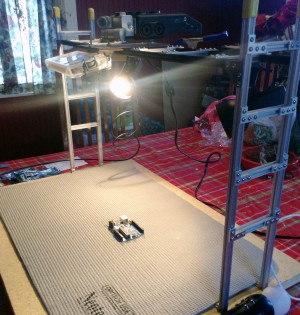
I needed to shoot some workbench videos, with a camera facing down at my hands that could be filming while I played with wires and electronic components. To accomplish this I built a POV rig with MicroRax aluminum t-slot beams, so I could focus on my work while still being able to see what I was recording. My rig consists of a wooden board with a gantry made out of aluminum beams, upon which the camera, mic, and lights are mounted. The board has an anti-static mat on it as well.
There are a couple of factors that you need to keep in mind before you size your project. You can make everything the way I did, but you aren’t guaranteed to get the results you want unless you take two measurements into consideration:
1) The size of the workspace. I based the size off of an antistatic mat I wanted to use with the POV rig. It’s an Op/Tech P/N 3611162 16″×24″ mat
2) Bear in mind the focusing characteristics of the camera, it may focus too close or far away from the surface, and positioning it at a certain height may offer better results than others.
I used an iPhone 4S, and the rig height I selected reflects this. I suggest taking some test videos with the camera positioned at various heights, and choosing the one that looks the best.













